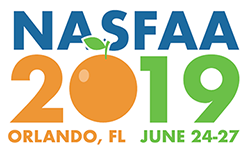Higher Ed’s Leaky Funnel: How FA Offices Can Be Part Of The Solution, 8:30 - 9:30 a.m.
By: Jill Desjean, Policy and Federal Relations Staff
In a Tuesday morning session, Angela Johnson, vice president of enrollment management & financial aid at Cuyahoga Community College; Daniel Barkowitz, assistant vice president of financial aid at Valencia College; and Lynn Higinbotham, associate vice president for enrollment management at New York University shared data as well as their institutions’ best practices for ensuring that students don’t fail to enroll or fail to complete their studies due to stumbling blocks in the financial aid process.
Noting a predicted 15% decline in the college-going student population in the next decade, the presenters cited more competition for fewer students as yet another motivation for institutions to find the financial-aid related barriers that cause students to drop out of college.
Johnson began with research from the National College Access Network, who studied 1.8 million low-income high school students to see where they got caught up in the financial aid application process. Their results show that more than 45% never completed the FAFSA, and of those who did, two-thirds were selected for verification, and one-fourth of those selected never enrolled in college.
Barkowitz then shared the results of a similar data analysis performed at his own institution, which enrolls about 63,000 students. Looking at FAFSA filers who ultimately enrolled at Valencia vs. those who did not, his team sought patterns that could help them identify areas they could improve their processes to enroll more of those students. While they observed that students selected for verification were less likely to enroll than those who were not, further research is needed to determine whether their data shows causation or merely correlation. They did, however, embark on a study of their internal verification processes and learned that they were “oververifying” — asking for more information than was required in regulations. Learning that 85% of the applications they verified had an Expected Family Contribution (EFC) change of $100 or less encouraged them to be less aggressive in their verification practices
Higinbotham began with a slide titled, “In Large Part, Financial Aid Melt is the Outcome of Excess Complexity and Poor Processes.” Noting that complexity is inherent in our profession, she urged that it is still essential to avoid adding unnecessary complexity. She noted that many processes in financial aid offices, while well-intentioned, are not effective, and that financial aid offices need to review their processes to ensure that we don’t get in our own way. As examples, she drew attention to live polling questions they had previously asked the audience, which were intentionally written in ways to confuse participants, with overly complex or unclear language, to demonstrate how difficult it can be for students and families to complete the financial aid process when the steps aren’t clear.
To tackle the barriers to completing the financial aid process, the presenters stressed the need for financial aid offices to evaluate communications to students and focus on eliminating jargon, not providing too much information at once, and timing communications to when the information being shared is most relevant to the step in the process the student is currently navigating.
Wrapping up, Barkowitz shared his office’s efforts to shift from operating as gatekeepers to acting as door openers, stressing the cultural attitude change required to change mindsets. Their communications now use growth language focused on helping instead of negative or penalizing language about the consequences of not following through. Higinbotham shared her office’s overhaul of the verification process and campus-wide efforts to make communications more standardized to enhance the student experience. And Johnson shared how her institution’s highly successful retention efforts, which previously focused on continuing students and non-financial aid related issues, have expanded to entering students and to financial aid topics like where students get stuck in the verification process.
Publication Date: 6/25/2019












You must be logged in to comment on this page.